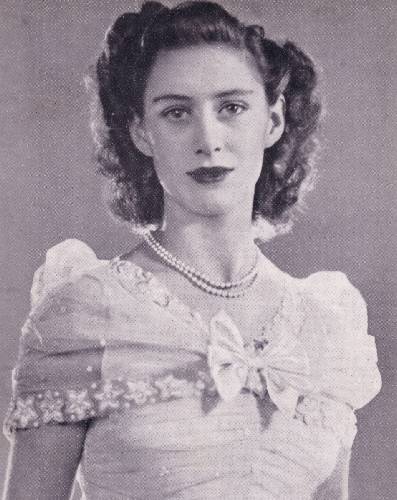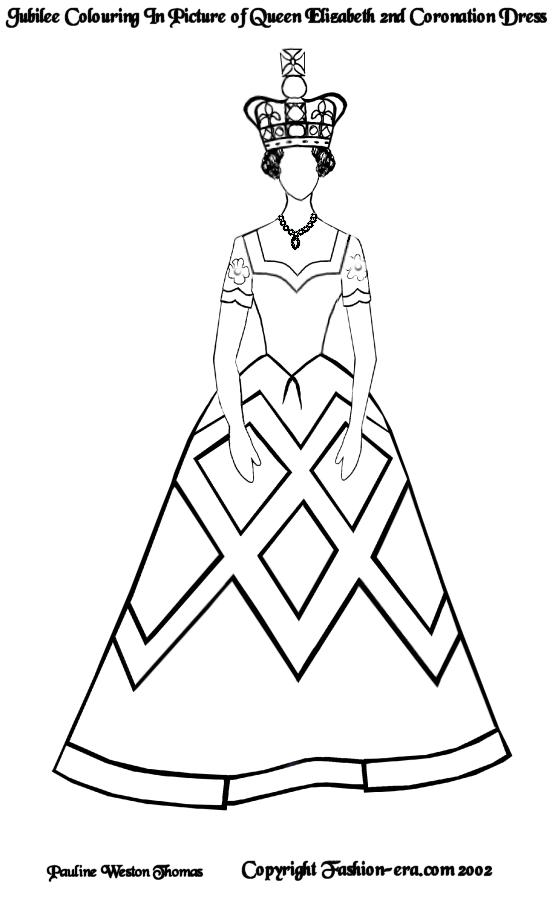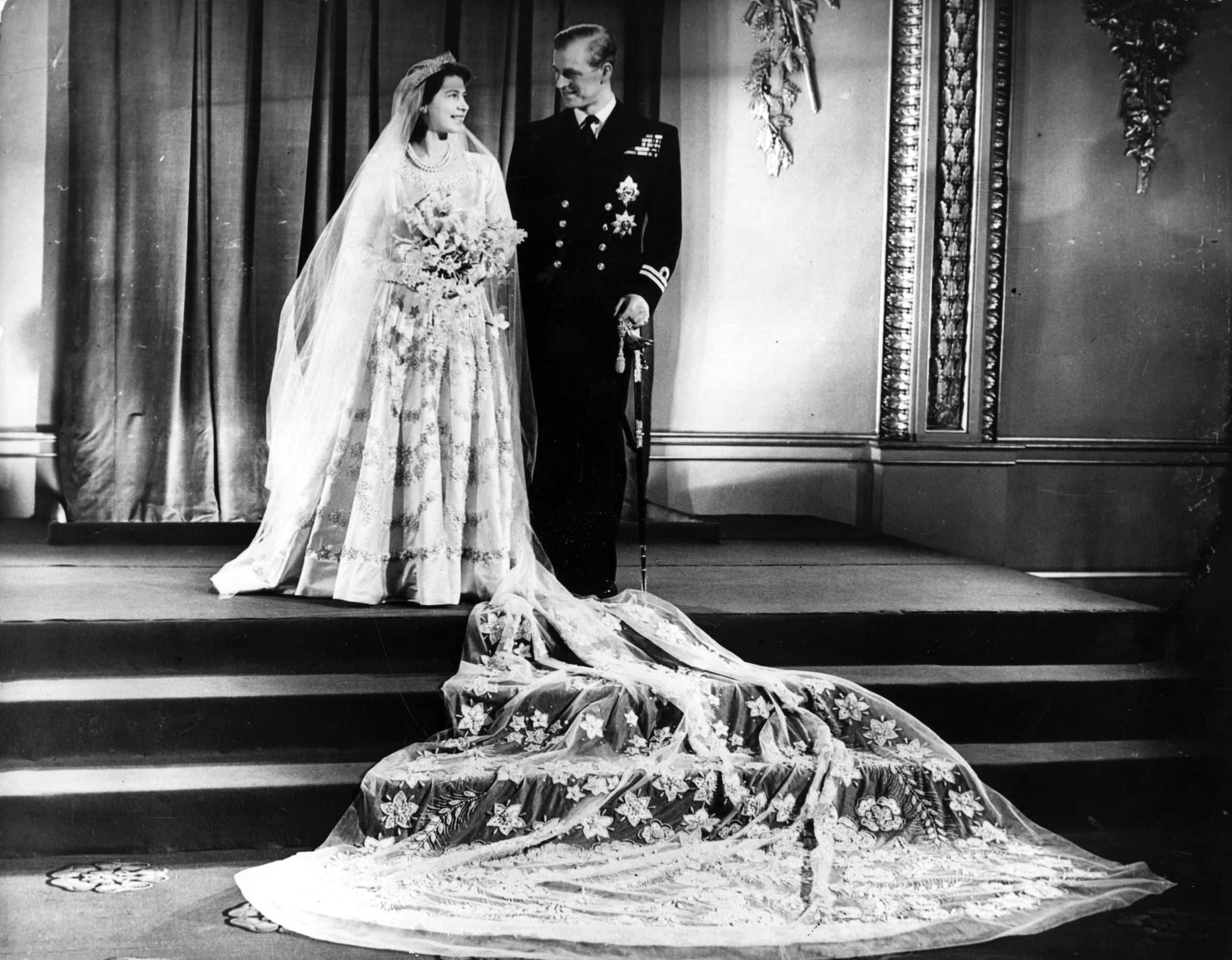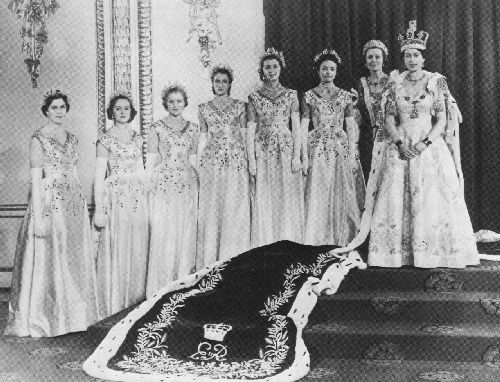By Pauline Weston Thomas for Fashion-Era.com
Table of Content
- The Queen's Wedding Dress Designer - Norman Hartnell
- Hartnell's Research
- Politically Correct Silkworms
- The Hartnell Wedding Dress
- An Interview with the Keeper of the Robes at the London Museum
- Between Wedding and Coronation
- Go to next page to the Queen's Ceremonial Coronation Gown
The Queen's Wedding Dress Designer - Norman Hartnell
In a sense, the Queen has been married twice. The first time she became wedded to Prince Philip; the second time at her coronation, she became wedded to the people. Each occasion demanded a dress of majestic beauty and on each occasion she chose dress designer, Norman Hartnell.
With his theatrical training, Hartnell was the ideal person to make spectacular dresses which would hold a stage of another kind.
Hartnell's Research
Less than three months before the wedding date, one of Hartnell's designs was approved and he began his research immediately.
He describes this in his autobiography (1955): 'I roamed the London Art Galleries in search of classic inspiration and fortunately found a Botticelli figure in clinging ivory silk, trailed with jasmine, smilax, syringa and small white rose-like blossoms. I thought these flora might be interpreted on a modern dress through the medium of white crystals and pearls.'
Because of Wartime restrictions, the pearls were not available in this country, and eventually Hartnell obtained twenty thousand of the correct pearls from America.
Once the pearls were in his possession Hartnell set about transferring the embroidery design to the paper pattern, but before the embroideresses could carry out the work Hartnell found himself in the throes of a publicity scandal.
You are reading an original 'Queen's Wedding Dress' royalty fashion history article by Pauline Weston Thomas at www.fashion-era.com ©
Politically Correct Silkworms
The Queen Mother had specifically asked that Hartnell should use an unusually rich, lustrous stiff satin which was made at Lullington Castle. The satin was ideal for the train, but Hartnell thought that the dress required a more supple material of a similar tone. He ordered the similar fabric from the Scottish firm of Winterthur near Dunfermline.
Difficulties arose when rivals put about the rumor that the Scottish satin was made from 'enemy silk worms', either from Italy or possibly Japan. A telephone call to Dunfermline settled the scandal. Mr. Hartnell has assured the silkworms were from Nationalist China and were not 'enemy silkworms'.
However politically correct the silkworms were, time has shown that the choice of silk was not a good one and below you can read some facts about the dress in my interview with Miss Kay Staniland, Keeper of the Robes in the London Museum in 1978.
But thirty years before in 1947 there was no immediate thought in Hartnell's mind that this would be a Museum piece of the future. His concern was to complete the gown as quickly and in as much secrecy as possible. Despite the many attempts of the press to bribe Hartnell's staff, the only glimpse newspapermen had of the dress, was when the covered four foot box containing the dress, left Hartnell's salon the day before the wedding.
Politically Correct Silkworms
The Queen Mother had specifically asked that Hartnell should use a.n unusually rich, lustrous stiff satin which was made at Lullington Castle.
The satin was ideal for the train, but Hartnell thought that the dress required a more supple material of a similar tone.
He ordered the similar fabric from the Scottish firm of Winterthur near Dunfermline. Difficulties arose when rivals put about the rumour that the Scottish satin was made from 'enemy silk worms', either from Italy or possibly Japan. A telephone call to Dunfermline settled the scandal. Mr. Hartnell was assured the silkworms were from Nationalist China and were not 'enemy silkworms'
However politically correct the silkworms were, time has shown that the choice of silk was not a good one and below you can read some facts about the dress in my interview with Miss Kay Staniland, Keeper of the Robes in the London Museum in 1978.
The Hartnell Wedding Dress and Pictures

The following day the Princess walked down the aisle of Westminster Abbey on the arm of His Majesty King George VI. Right - Now we are married...
The richly embroidered white satin wedding dress shimmered with her every movement. Softly spaced throughout the dress were garlands of pearl orange blossom, syringa, jasmine and White Rose of York.
These were skilfully combined with flowing lines of wheat ears, the symbol of fertility, and worked in pearl and diamante.

The Royal Wedding Group
The design was repeated throughout the length of the fifteen foot train and repeat motifs of embroidery bordered the sweetheart neckline, the long satin sleeves and the hem.
Similar motifs were also featured on the complementary bridesmaids' dresses.
Wisely, the Princess rejected the usual heavy heirloom lace so often worn by Royal brides, and instead chose a flattering soft white tulle veil that was half the length of the train. With it she wore a small Russian-style sunray fringe tiara and a single row of pearls.

You are reading an original 'Queen's Wedding Dress' royalty fashion history article by Pauline Weston Thomas at www.fashion-era.com ©.
The London Museum in 1978

An Interview with the Keeper of the Robes
In the interests of posterity it might have been wiser to have used satin from another source, since the fabric used is quite rotted. At an interview in the London Museum in 1978, Miss Kay Staniland, Keeper of the Robes, told me that the Queen's wedding dress, which has been displayed several times, was in an appalling condition; the main problem being the silk used for the dress.
Miss Staniland described the silk as being very heavily tin weighted. She explained that the tin weighting was contributing to the continual deterioration of the fabric, speeding up the rotting process which starts as soon as any fabric is removed from the loom.
In the early 1970s, the dress was displayed with half a dozen other Royal wedding dresses. When Miss Staniland attempted to fit the Queen's dress to its polystyrene dress form she found that the weight of the embroidery dragged the skirt down, increasing the strain on the weave.
To have left the dress on the form as it was, would have resulted in the skirt tearing from the bodice. The problem was solved by the construction of a calico skirt with tapes. This was used to support the heavy embroidered skirt and was secured to the form, without adding strain to the bodice.
Despite the fact that I was a serious costume student I was not allowed to even see, let alone handle the gown using special conservation gloves. However Miss Staniland kindly went to some trouble to show me photographs of the back view of the dress.
The back fastening of the dress was not a zip, but a series of fourteen tiny covered buttons which were spaced closely together and stopped at the base of the spine. All the buttonholes had unravelled and beneath these there was a zip for additional support.
The left sleeve was badly frayed; the head having come completely away from the armhole, revealing a tear in the armpit. Some of the underarm degradation of the fabric was due probably to the combination of the metal salts in the silk and underarm perspiration which together speeded up the disintegration process.
Anyone standing under intense camera lights knowing they would be watched by millions combined with the occasion of a marriage ceremony would perspire a great deal.
The keeper confided that gowns of this type were a nightmare to display and handle and from the Museum's point of view, the condition of this comparatively new dress was classified as poor. Already it was a conservation problem limiting the length of time it could be displayed even in the most carefully controlled conditions.
Considering I was given that information a quarter of a century ago one can only speculate at the condition of the gown today.
You are reading an original 'Queen's Wedding Dress' royalty fashion history article by Pauline Weston Thomas at www.fashion-era.com ©.
Between Wedding and Coronation
Within three years of the wedding ceremony, the Princess was a mother of two infants and it was at this period that press columnists began to describe her as 'dowdy' and 'frumpish'. Hartnell continued to design clothes for her, but they were still very much in the matronly styles favoured by the elder women who surrounded her, but particularly by her mother and Queen Mary.
The description was very unkind and it's also important to remember that in the early 1950s women dressed like their mothers to appear older and more sophisticated unlike today when mothers hope to be taken for their daughter's friends.
Princess Elizabeth's first attempt at adventurous clothing was abortive. Several dresses were ordered from the House of Molyneux for the Commonwealth Tour of 1952.
During the first week of the tour, before Princess Elizabeth had a chance to wear any of them, news came of her father's death. They were never worn publicly because shortly after, Princess Margaret was heavily criticised by the British Fashion Houses for wearing Paris made Dior dresses rather than supporting British couturiers.
At the news of the King's death, the court went into mourning, and four thousand miles away at Sagana Royal Lodge in Kenya, hasty arrangements were made to fly the new Queen back to Britain via Entebbe. When she boarded the Dakota plane she wore a summery beige dress smattered with white flowers, a white hat, and white accessories. Photographers were asked not to photograph her, so there is no record of Elizabeth II on her accession day.
At Entebbe airport she changed planes and there was able to change into mourning clothes, which are always present somewhere amongst Royal luggage in case of unexpected death. When Elizabeth II stepped out of the plane onto English soil, she was wearing deep black.
The first person to kiss her hand was the aged Queen Mary. At the same time she is reported to have indicated her disapproval of the Queen's coat, saying, 'Much too short for mourning'. From the photographic evidence available it seems that the young Queen was developing a mind of her own. The coat she wore at her father's funeral appears to be no longer than the one criticised by Queen Mary.
Within days of the Queen's accession, Committees were formed and skeleton plans for her Coronation were outlined. The day of ceremony was to be June 2nd, 1953, some sixteen months later, during which time thousands of people had to spend thousands of hours involved in the arrangements.
Once again Norman Hartnell was to play a part and in October 1952, he was summoned to the palace where he received his Coronation brief to design the Coronation ceremonial robes.
Free Basic Colouring In Picture of Queen Elizabeth II's Coronation Gown

This colouring-in picture of the Queen's Coronation Dress would be very suitable for younger groups where bold shapes are important.
I became aware in early May 2002 that people were seeking colouring in pictures to use in school jubilee fashion history project work. I have made a very basic outline sketch of the Queen's Coronation Gown suitable for children to either colour or use as a guideline for fabric or paper collage.
The sketch should be satisfactory as a handout for a lesson on for example the importance of the constitution, or simply for fun colouring in during jubilee school celebrations or as part of a street party goody bag containing felt pens or crayons.
The sketch would also be suitable for a teacher to scale up for a large wall mural with different children working on specific sections. The file has been scaled to print out to A4 size. Just double-click the picture and print off when downloaded or save to disk. It will also open in Microsoft Word if you have limited picture software. For instructions to open files in Word see my page called Fashion Drawing.
Note - the Queen wore a Diadem to the Abbey and wore the Crown after the coronation ceremony on the return journey.
(Copyright © 1977-2007.These pictures may not be used as part of a CD or electronic device for sale purposes, but may be printed off in multiple copies for school, nursery or street parties.)
You have been reading an original 'Queen's Wedding Dress' royalty fashion history article by Pauline Weston Thomas at www.fashion-era.com ©.
Page Added 2001 - Amended 2009.
Note - This page on the Queen's wedding dress is based on some content taken from a dissertation called:- Elizabeth II - The Splendour Of Regal Wear which I wrote in 1978. The dissertation looked at the symbolism behind the decorative embellishment on ceremonial dresses worn by the Queen and how the decoration on those dresses could be used as a starting point to create fresh new design ideas.

